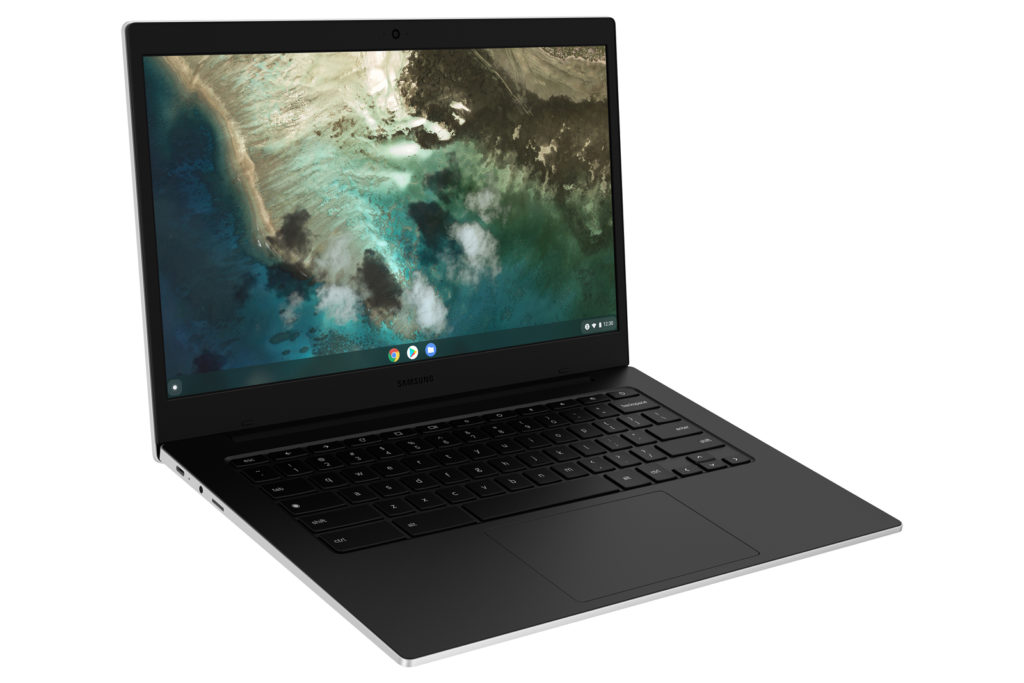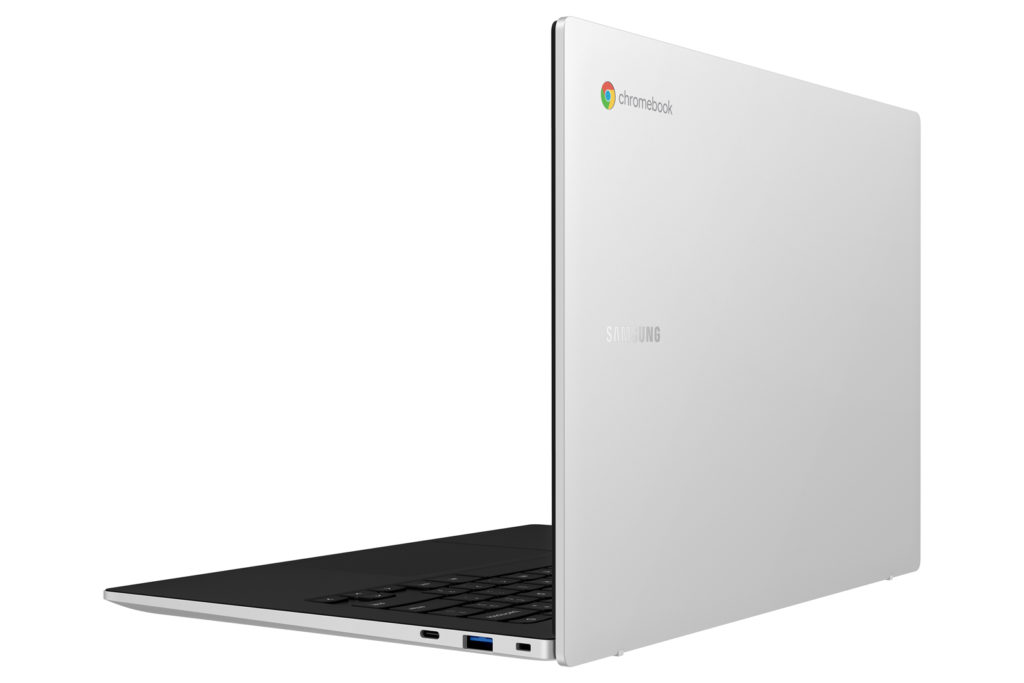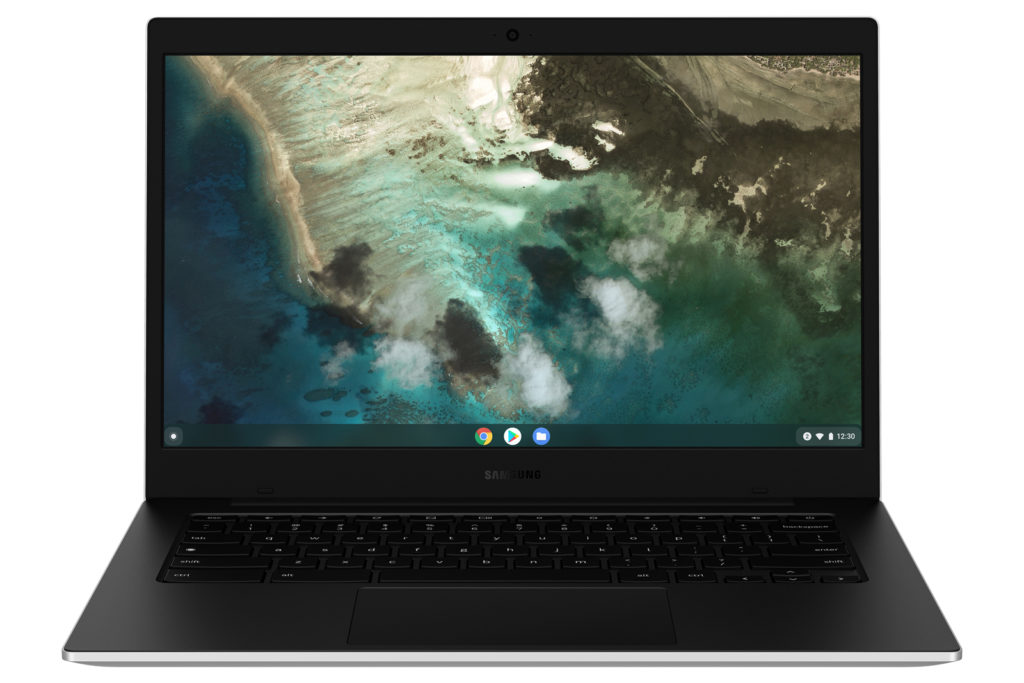Quietly announced last month, the Samsung Galaxy Chromebook Go is now available direct from Samsung. You can order the Wi-Fi model now for $299.99. Samsung tells me an LTE version will arrive in the coming weeks. Additional retailers will carry the 14-inch slim Chromebook as well.
Many thought Samsung would use Qualcomm’s Snapdragon 7c chipset in a new Galaxy Chromebook, like the Acer Chromebook Spin 513. That’s not the case.

The Samsung Galaxy Chromebook Go is powered by an Intel Celeron N4500 processor, 4 GB of onboard DDR4x memory and 32 GB of eMMC storage. You can add additional storage capacity through the microSD card slot, but memory is fixed at 4 GB.
The internals are what you’d expect for the $299.99 price tag.
And although it would be nice if the 14-inch display was 1920 x 1080 resolution, it isn’t. This is a 220 nit, 1366 x 768 non-touch panel with a 16:9 aspect ratio. So, not great for outdoor usage and the minimum resolution you’ll find on a Chromebook these days.

That said, the convertible design looks nice and you do get a 720p webcam, pair of USB Type-C ports and one Type-A. WiFi 6 and Bluetooth 5.1 are also supported.
Again, a higher resolution display would be nice but for basic web usage, home and school activities, this isn’t a bad-looking entry-level Chromebook.
I don’t yet know the price of the LTE model, but here in the US, there will be configurations that work on either AT&T or Verizon networks. I’m expecting a good $120 premium for that LTE radio, plus your monthly service.
Adding LTE into an entry-level Chromebook like this doesn’t make the most sense to me as the target audience is probably more cost-conscious. Even so, it’s great to see another LTE Chromebook option, which I’ll be adding to the list I posted earlier this week.



6 Comments
❝Adding LTE into an entry-level Chromebook like this doesn’t make the most sense to me as the target audience is probably more cost-conscious.❞
Especially since Chromebooks have Instant Tethering, it doesn’t make sense for anyone that can use their smartphone to create a Wi-Fi hot spot, which is basically everyone. Just my opinion, of course. But the target audience is highly unlikely to add another data connection to their AT&T or Verizon bill. Really makes me wonder what Samsung marketing was thinking. ?
Tethering only works when you have a strong LTE/5G signal. There have been PLENTY of times when I wished that my Chromebook had its own mobile signal. Another issue: tethering kills the smartphone battery because it has to continuously run 2 radios instead of one, plus transmitters need more power than receivers. So, if you are going to do this for any length of time you are going to need to connect your phone to a charger. But this precludes USB tethering, which is fastest.
Also, developing nations are the ones where cheap LTE Chromebooks have the most potential. You have heard about all the markets where “Android phones are the primary/only computing devices”. Some of that is due to income, granted, but also because there are few Wi-Fi providers. So being able to pick up a laptop that costs about the same as a Xiaomi Redmi Note or Vivo V20 and put it on the same LTE plan as your phone could potentially greatly expand Chromebook sales – and computing in general – in certain markets.
Another thing: cheap LTE and 5G ChromeOS 2-in-1s would be PERFECT for Google to use to promote their own Google Fi service. They could even have a campaign going where they would encourage you to keep your smartphone on your current plan but put your Chromebook on Google Fi. It could even be part of some bundle where you get Stadia, YouTube TV, Google Photos/Drive storage, Google Play Pass etc. And if you like Google Fi with your Chromebook, then use it with your next smartphone too … using the same phone number that you already have with Google Fi for your Chromebook.
There is real potential here. But it looks like Google is going to put Whitechapel in $2000 folding phones that no one wants instead of $400 ChromeOS 2-in-1s that everyone wants.
LTE currently exists on Chromebooks in the price range of smartphones. Nothing prevents those scenarios. They’ll have to move the needle with sales to find greater adoption. Personally, I think that LTE for Chromebooks is nice feature. But all features come at either a cost or a sacrifice of some other feature.
On second thought, you do have to turn on the Wi-Fi hot spot on your smartphone. It’s more convenient not to have to take those few seconds to fiddle with the phone. Is that convenience worth the price? Depends on the patience of the person or aptitude of the kid, I suppose.
“Many thought Samsung would use Qualcomm’s Snapdragon 7c chipset in a new Galaxy Chromebook, like the Acer Chromebook Spin 513. That’s not the case.”
This is Google’s fault. In the early ChromeOS era, Samsung used their own SOCs for ARM-powered LTE Chromebooks. Then for reasons that only make sense for Google, they stop approving ARM boards for everything but low-end MediaTek ones for like 6 years. They also never did anything with LTE or 5G on ChromeOS and ultimately did everything they could to make ChromeOS just another x86 PC platform. So where Google and Samsung should have worked together to make and promote ChromeOS devices that use their Exynos SOCs – and in the US are on the Google Fi cellular network for Messages, Duo, Meet, Stadia etc. – right now Samsung has no incentive to do anything else but use outdated and cheap Intel CPUs like everyone else to keep R&D and manufacturing costs down.
Right now, Samsung is forced to use Qualcomm SOCs for their tablets and phones even though they really don’t want to. Chromebooks would have been an excellent platform for them to sell 10 million (or more) devices using their own SOCs. As it is, as Samsung can’t do things like put DeX or their own apps and services on ChromeOS, they have a much bigger incentive to make and promote Android tablets – which does allow them to do those things – and not even sell Chromebooks in South Korea. But give Samsung the opportunity to sell Chromebooks with Exynos SOCs instead of tablets with Qualcomm ones, they would take that up in a minute.
Maybe there’s a market for education devices with LTE in low income areas where parents don’t have wifi, maybe they only have cheap smartphones on low data plans – but kids still need access to do homework?